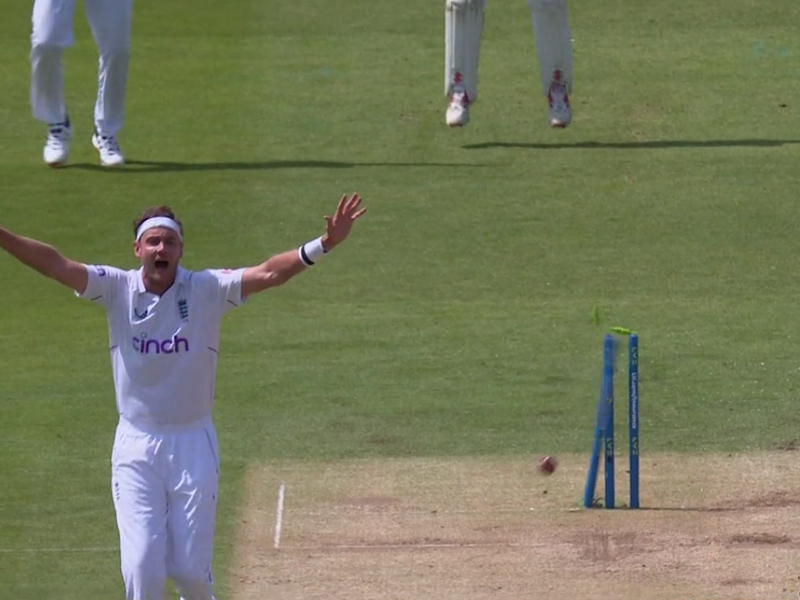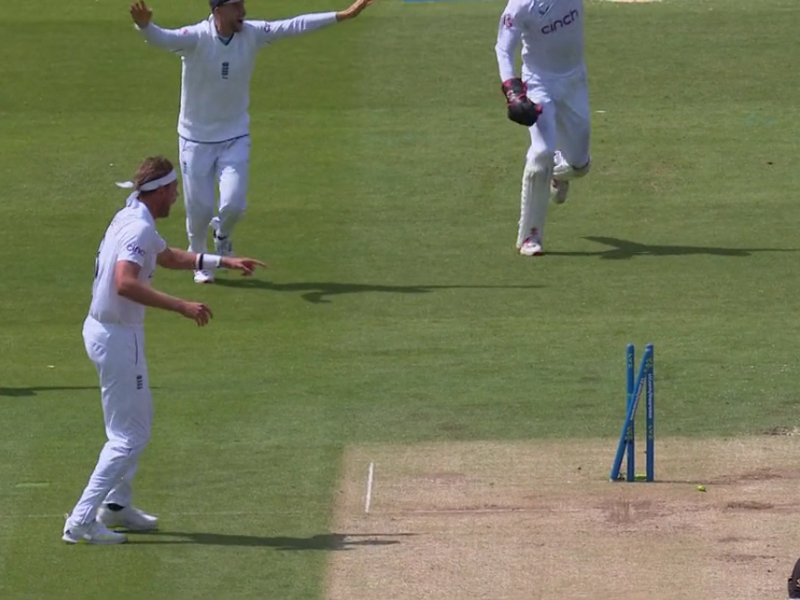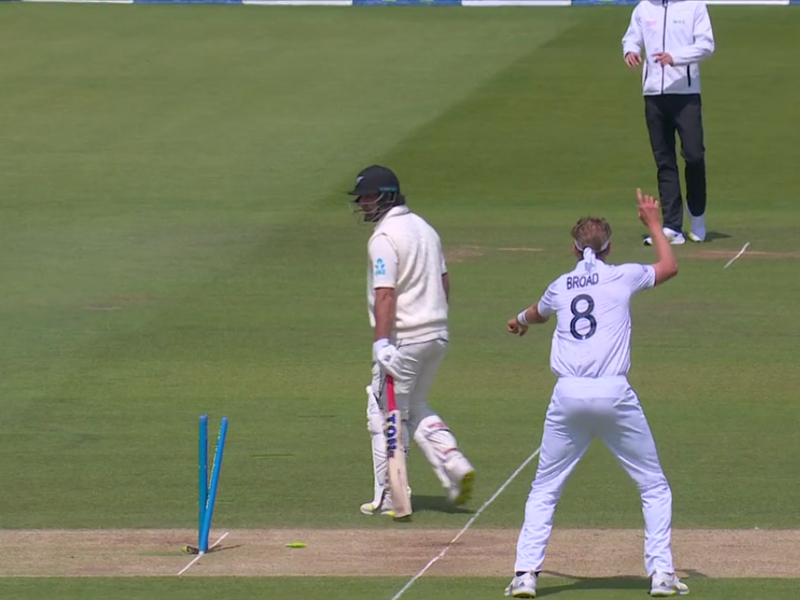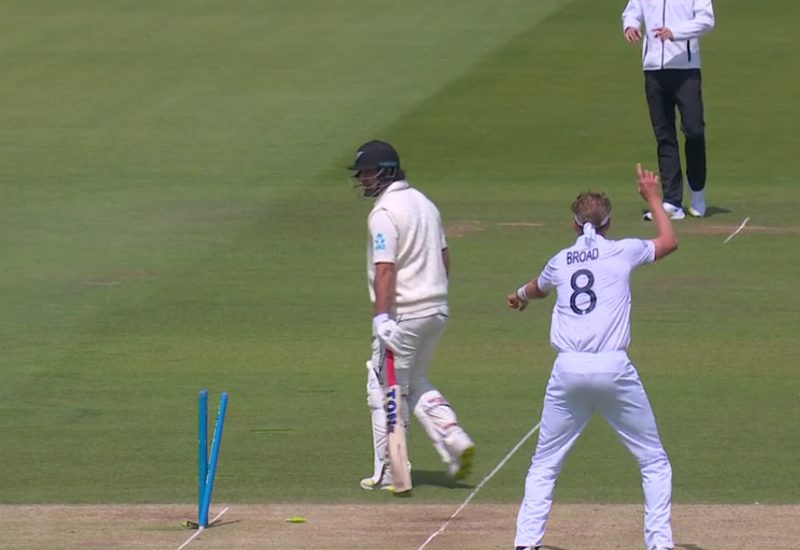Appealing is one of the great aspects of cricket and Stuart Broad is, in his own way, one of the all-time great appealers. At Lord’s, against New Zealand, he delivered a very fine secondary appeal.
If you missed it, Colin de Grandhomme was run out by Ollie Pope at slip while Stuart Broad was appealing for LBW.
This is how much Broad saw of the crucial moment.

What we like about the image above is how it indirectly highlights the innate excitability that underpins so much of Broad’s entertaining/annoying on-field work.
He has no way of knowing for certain that de Grandhomme is out. All that matters is that he might be. And that is all you need for an appeal. That alluring possibility.
So when Broad then notices that de Grandhomme’s stumps are down, he is visibly THRILLED.

The potential dismissal completely washes away all the disappointment of the turned-down LBW appeal in an instant.
Pointing like a giddy toddler, he gives de Grandhomme out.

Still high on the elation, he then bowled Kyle Jamieson next ball.
You can get our articles by email, if you want.





The very best appeal was for Latham caught off Potts in the 2nd innings (https://www.bbc.co.uk/iplayer/episode/m0017x1w/cricket-today-at-the-test-england-v-new-zealand-2022-first-test-day-two-highlights at 19:30 for those with iplayer or https://twitter.com/SkyCricket/status/1532691775093190656 but I don’t know how long Sky keep those clips up). The slips and bowler calebrappeal convincingly enough for the umpire to give it. Foakes who catches it makes his “oooh, good ball, almost drew an edge!” face but doesn’t seem to appeal or celebrate at all. Hence convincing the batsman to burn a DRS review despite having pretty clearly hit it. You could probably make a proper tactic out of that.
Love this piece.
Daisy and I missed that pivotal stage of the match, as we needed to attend to The Duchess, who now, sadly, is no longer able to take in cricket.
But we were at Lord’s today for the denouement, which made our weekend and was well worth the price of admission.
A win against the World Test Champions is a fine start to the season. Leaving aside the fact that ten of our wickets were taken by two players with a combined age of just under 76, this surely gives us hope for the future. Leaving aside also that apart from our recently sacked captain, our top five scored 141 runs in two innings, and surely this is a moment for huge optimism. And leaving aside… (you get the picture).
But that’s not the best thing. The best thing is that despite being exactly the same age as Alastair Cook when reaching 10,000 runs (31 years and 157 days) Root was in fact a day younger. This is a tremendous piece of statistics. They were all going on about it yesterday, wondering what time of day Cook and Root were born, when all along it didn’t matter. Root has won the competition by simply living through fewer actual days than Cook.
Hmmm – I make it eight leap days each prior to the record, so I’m wondering how your computation works, Bert.
Cook had lived through a leap day during the year in which the milestone was achieved, whereas Root hadn’t. I think the statos had adjusted for that when quoting the number of days since each of their previous birthdays.
But on the lifetime basis, surely Cook had lived through one day fewer (25 December 1984 to 30 May 2016) than Root (30 December 1990 to 5 June 2022), not one day more.
Question for advanced students – does any of this really matter?
Of course it matters. For future selection purposes, we need to know exactly how long it will take our next batsman to get 10k runs. We already know that their surname has to be _OO_, this is just the next piece in the jigsaw. Yes, we’re looking at you, Mark Wood.
It’s always difficult to argue with your logic, Bert.
We’re the greatest cricket team in the world, arse, shove, spake, etc.
About to post a comment, as a reply to this one, which I think will get caught in moderation due to multiple links, but I think it is worth sharing….
Yesterday I became aware of DALL-E Mini, an Artificial Intelligence app based on the more powerful but less open-to-the-public DALL-E, which will generate images based on ‘natural language’ prompts.
Prompts such as ‘cricketer eating a pie’, and images such as the below-linked:
https://ibb.co/f0YpHtL
https://ibb.co/s5P0N0H
https://ibb.co/CJJtHYM
https://ibb.co/64QnRW1
https://ibb.co/XSSPWT7
https://ibb.co/2ZdyBCR
Nightmarish.